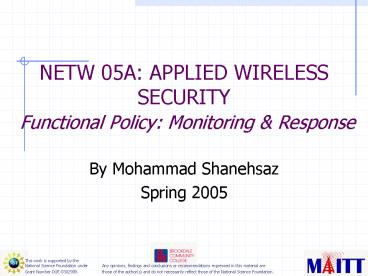NETW 05A: APPLIED WIRELESS SECURITY Functional Policy: Monitoring - PowerPoint PPT Presentation
1 / 15
Title:
NETW 05A: APPLIED WIRELESS SECURITY Functional Policy: Monitoring
Description:
This work is supported by the National Science Foundation under Grant Number DUE ... NETW 05A: APPLIED WIRELESS SECURITY. Functional Policy: Monitoring & Response ... – PowerPoint PPT presentation
Number of Views:80
Avg rating:3.0/5.0
Title: NETW 05A: APPLIED WIRELESS SECURITY Functional Policy: Monitoring
1
NETW 05A APPLIED WIRELESS SECURITY Functional
Policy Monitoring Response
- By Mohammad Shanehsaz
- Spring 2005
2
Objectives
- Security management
- Explain the necessary criteria for regular
wireless LAN security reporting and documentation - Implement and conduct timely and consistent
reporting procedures - Implement maintain wireless LAN security
checklist
3
Objectives
- Explain how to identify and prevent social
engineering - Educate staff and security personnel
- Implementation and enforcement of corporate
policy regarding social engineering - Security marketing and propaganda campaigns to
heighten awareness
4
This lecture covers
- Physical Security
- Social Engineering
- Reporting
- Response Procedures
5
Physical Security
- Physical security begins with allowing only
authorized personnel into and out of the
organizations premises, by implementing security
and educating staff about the risks prevent - placement of Rogue access points and Ad Hoc
networks on the wired network, and - data flooding.
- RF jamming is more difficult to prevent, detect,
or block, but it can be done by putting up high
fences that block RF transmissions around
facility, or using mesh substances in the wall
6
Physical Security
- Security policy must include documentation on
physical security, - procedures for authorizing visitors or
technicians who show up to repair and upgrade
systems, - how rogues will be found,
- how often the area will be scanned and
- what to do when rogues are found
7
Social Engineering
- By training employees and help desk staff we can
raise their awareness to recognize and prevent
social engineering. - Social engineering attacks come in many forms
such as - Dumpster diving - searching through the trash
- Phone calls - attackers try to locate willing and
helpful people from whom to obtain information
such as usernames and password - Email and IM (instant messaging ) - a social
engineer gathers a phone directory and
information on the standard naming conventions
for IM, and then masquerades as a legitimate
employee
8
Social Engineering Prevention
- Some of the procedures support and administrative
personnel should adhere to are - Positively identify the person that is calling or
requesting help - Use established, secure channels for passing
security information - Report suspicious activity or phone calls
- Establish procedures that eliminate password
exchanges - Shred company documents before throwing them in
the trash
9
Social Engineering Prevention
- A well-educated employee is the best defense
against social engineering attempts, they must
become familiar with what types of attacks may
occur, what to look for, and how to respond to
incident - An organizations security policy should dictate
proper response procedures for social engineering
threat
10
Social Engineering Audits
- To reduce the threat of social engineering have
defenses tested for weaknesses by penetration
tests, including social engineering attacks
against organizational staff, performed by
security professionals
11
Reporting
- Reports that are generated as part of security
monitoring procedures can provide valuable
information on how the network is being utilized
as well as where attacks are occurring. - A proper reporting policy will include
information on who is accountable for generating
the reports and who is responsible for reading
the reports in a timely manner - Training should also be required for the
reviewers - System logs and IDS logs can be used to detect
anomalies and attacks on a network - Traffic baselining of data flow establishes which
users or devices are utilizing the most WLAN
bandwidth
12
Response Procedures
- Response procedures endeavor to detect and
properly react to intrusions - A security policy should define the steps to take
after an intrusion has been recognized, to
prevent the attack from occurring again
13
Recommended steps for response procedures
- Positive identification
- Administrator must be properly trained to
distinguish between an attack and false positives - Confirmed attack
- After an attack has taken place, damage must be
assessed and confirmed, and appropriate managers
should be notified
14
Recommended steps for response procedures
- Immediate action
- If an attack has taken place follow the
documented security policy to implement the
appropriate procedures for each type of attack
scenario - Documentation
- Document all attack findings in a standard form
generated by the organization and add to the
security policy - Reporting
- Notify the appropriate authorities, Corporate
legal counsel, police and even IT forensics
experts
15
Resources
- CWSP certified wireless security professional,
from McGraw-Hill































